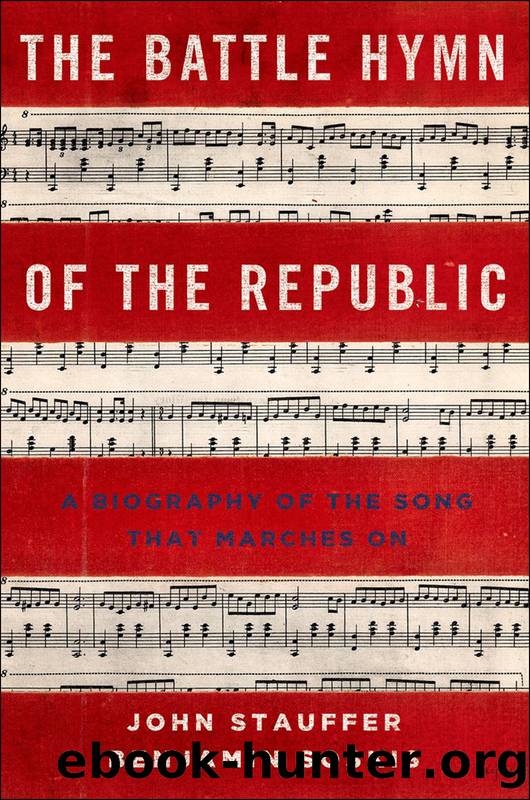The Battle Hymn of the Republic by Stauffer John;Soskis Benjamin; & Benjamin Soskis

Author:Stauffer, John;Soskis, Benjamin; & Benjamin Soskis
Language: eng
Format: epub
Publisher: Oxford University Press, Incorporated
Published: 2013-08-15T00:00:00+00:00
VII
* * *
THE EVANGELICAL âBATTLE HYMNâ
ON APRIL 7, 1917, the day after the United States declared war on Germany, Billy Sunday arrived in New York City. Sunday was considered by many the greatest revivalist in American history, some said âthe greatest since the days of the apostles.â He had been preaching for twenty years, his audiences rapidly growing from whistle-stop towns in Iowa to the wicked cities, which were, he believed, polluting the surrounding countryside and threatening the nationâs spiritual fabric. He had recently achieved extraordinary successes in Boston and Philadelphia, where he filled ten-thousand-seat tabernacles built especially for his two-month campaigns. But New York, that âmodern Babylonâ and âcapital of Satan,â was considered the graveyard of evangelists. The revival there would be the most important of his career.1
Billy Sunday (his true name) was well prepared for it. His advisors included John D. Rockefeller Jr. (âold chap,â Sunday called him); Major General Leonard Wood, a Congressional Medal of Honor winner who had captured Geronimo during the Indian wars and commanded the Rough Riders in Cuba; and former president Theodore Roosevelt, who once told Sunday, âThere is no man, in recent years, who has done better work than you, in this country.â A massive wooden tabernacle that held twenty thousand had been built on the corner of Broadway and 168th Street, the largest public venue at that time erected in New York. And Sunday had an army of some fifty thousand volunteer organizers to help with his campaign. They built the tabernacle, reached out to the cityâs churches, held prayer meetings and choir rehearsals, raised money, and aggressively advertised Sundayâs campaign to âsave New York.â2
At the first service, on April 8, the tabernacle was filled to capacity hours before its 2 P.M. start. There was a two-thousand-voice choir and a professional orchestra with two grand pianos. But the crowd was there to hear and watch Billy Sunday, who was famous for his theatrical, athletic sermons. For eight years before turning to God he had played professional baseball, and his record for bases stolen in one season (ninety-five) stood until Ty Cobb broke it twenty-five years later. He began his sermon by comparing the tabernacle crowd to those at the ballpark when he had played in New York: âYouâre the same warm-hearted, enthusiastic bunch you used to be when you sat in the grandstand and bleachers when I played at the old Polo Grounds.â3
His sermon emphasized the evangelical tenet of repenting oneâs sins and accepting Jesus as oneâs personal Savior, in contrast to the teaching of religious liberals (or modernists), who believed that all humans could be saved without a conversion experience. âI donât believe in the universal Fatherhood of God and the universal brotherhood of man. Youâre a creature of God. So is a hog eating slop out of a trough. Youâve got to be a child of God.â Only conversion through the Holy Spirit could make men and women children of God.4
After that warm-up, Sunday paced across the stage, pointing at the crowd and railing against sin and the devil.
Download
This site does not store any files on its server. We only index and link to content provided by other sites. Please contact the content providers to delete copyright contents if any and email us, we'll remove relevant links or contents immediately.
Fangirl by Rainbow Rowell(8808)
How to Bang a Billionaire by Alexis Hall(7941)
Wonder by R. J. Palacio(7750)
The Space Between by Michelle L. Teichman(6589)
The Thirst by Nesbo Jo(6458)
Assassin’s Fate by Robin Hobb(5867)
Wiseguy by Nicholas Pileggi(5335)
The Night Circus by Erin Morgenstern(5044)
The Kite Runner by Khaled Hosseini(4963)
Paper Towns by Green John(4815)
Bittersweet (True North #1) by Sarina Bowen(4720)
Gerald's Game by Stephen King(4386)
Too Much and Not the Mood by Durga Chew-Bose(4105)
Pillow Thoughts by Courtney Peppernell(4035)
Goodbye Paradise(3464)
Twelve Days of Christmas by Debbie Macomber(3421)
Good by S. Walden(3361)
The Rosie Effect by Graeme Simsion(3223)
The Cellar by Natasha Preston(3081)
